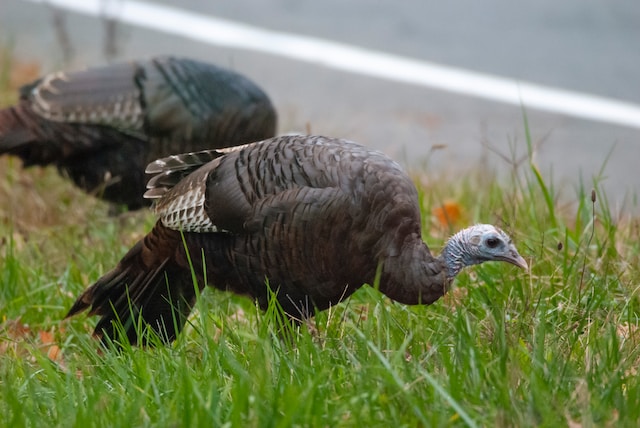What Do Wild Turkeys Eat? A Comprehensive Guide to Their Diet

Wild turkeys are fascinating birds that can be found throughout North America. They are known for their unique appearance, with colorful feathers and a distinctive wattle on their necks. But what do they eat? Understanding the diet of wild turkeys is key to understanding their behavior and habitat.
Wild turkeys are omnivores, meaning they eat both plants and animals. Their diet varies depending on the season and what is available in their environment. During the spring and summer months, they primarily feed on insects, spiders, and other small creatures.
In the fall and winter, their diet shifts to nuts, seeds, and berries. They are also known to eat small reptiles and amphibians when they can find them.
Wild Turkey’s Dietary Habits
Wild turkeys are omnivores, meaning they consume both plant and animal matter. Their diet varies depending on the season and availability of food sources. In general, turkeys consume a wide variety of foods, including:
-
Seeds and nuts: Wild turkeys feed on a variety of seeds and nuts, including acorns, hickory nuts, beechnuts, and chestnuts. These foods are particularly important during the fall and winter when other food sources are scarce.
-
Fruits and berries: During the spring and summer, wild turkeys feed on a variety of fruits and berries, including blueberries, blackberries, raspberries, and grapes.
-
Insects: Insects are an important source of protein for wild turkeys. They feed on a variety of insects, including grasshoppers, crickets, beetles, and ants.
-
Small animals: Wild turkeys have been known to eat small animals, including lizards, snakes, and rodents. However, these foods make up a small portion of their diet.
-
Grasses and other vegetation: Wild turkeys also consume a variety of grasses and other vegetation, including clover, alfalfa, and dandelions.
Overall, wild turkeys have a varied diet that allows them to adapt to changing food sources throughout the year. They are opportunistic feeders and will consume whatever food is available to them in their habitat.
Seasonal Eating Patterns
Wild turkeys have a varied diet that changes with the seasons. In the spring, they eat different foods than they do in the fall or winter. Understanding the seasonal eating patterns of wild turkeys can help hunters, wildlife enthusiasts, and conservationists better manage turkey populations.
Spring Diet
In the spring, wild turkeys primarily eat insects, seeds, and green vegetation. They need to build up their strength after the winter, and the abundance of insects and fresh vegetation helps them do so. Some of the insects they eat include grasshoppers, beetles, and caterpillars. They also eat seeds from grasses and wildflowers.
Summer Diet
In the summer, wild turkeys continue to eat insects and seeds, but they also eat more fruits and berries. Some of the fruits they eat include blackberries, blueberries, and wild grapes. They also eat acorns and other nuts that start to ripen in the late summer.
Fall Diet
In the fall, wild turkeys shift their diet to focus on nuts and seeds. Acorns are a favorite food, but they also eat other nuts, such as hickory nuts and beechnuts. They also eat berries and fruits that are still available.
Winter Diet
In the winter, wild turkeys rely heavily on seeds and nuts that they have stored up during the fall. They also eat buds and twigs from trees and shrubs. In areas where snow covers the ground, they may have difficulty finding food and may resort to eating bark or even small animals, such as mice.
Overall, wild turkeys have a varied diet that changes with the seasons. Understanding their seasonal eating patterns can help us better manage their populations and ensure their survival.
Food Sources in Different Habitats
Forest
Wild turkeys in forested areas have a diverse range of food options. They feed on acorns, nuts, seeds, berries, and insects. Insects are an important source of protein for turkeys, and they can be found in abundance in the forest. Turkeys also consume small mammals and reptiles, such as lizards and snakes.
Fields
Fields are another important habitat for wild turkeys. In these areas, turkeys feed on a variety of grasses, plants, and seeds. They also consume insects, especially grasshoppers and crickets. In agricultural areas, turkeys may also feed on crops such as corn and wheat.
Shrubs
Shrubs and other woody vegetation provide another food source for wild turkeys. They consume the leaves, fruits, and seeds of shrubs such as dogwood, sumac, and blackberry. Turkeys also feed on the buds and twigs of shrubs during the winter months when other food sources are scarce.
Overall, wild turkeys are adaptable birds that can survive in a variety of habitats. They have a diverse diet that includes both plant and animal matter. By understanding the food sources available in different habitats, we can better understand the behavior and ecology of these fascinating birds.
Importance of Water and Grit
Wild turkeys have a unique diet that consists of both plant and animal matter. To ensure proper digestion, they need access to water and grit.
Water is essential for the digestion of food and the regulation of body temperature. Wild turkeys obtain water from various sources, including streams, ponds, and puddles. They also consume snow during the winter months when other sources of water may be scarce.
Grit is small, hard particles of sand, gravel, or stone that wild turkeys consume to aid in the grinding and digestion of food. The grit helps to break down tough plant material and animal matter, such as insects and small rodents.
Wild turkeys obtain grit from a variety of sources, including dirt, gravel roads, and rocky areas. They may also consume small stones and pebbles found near water sources.
In summary, water and grit are essential for the proper digestion and overall health of wild turkeys. Providing access to these resources can help attract and support wild turkey populations.
Conclusion
Wild turkeys are omnivores that feed on a variety of foods depending on the time of year and availability. Their diet is diverse and includes seeds, nuts, fruits, insects, small animals, and even reptiles. They are opportunistic feeders and will eat whatever is available in their habitat.
During the spring and summer, wild turkeys feed on insects, spiders, and other small invertebrates. They also eat a variety of plants, including grasses, leaves, and flowers. In the fall, they shift their diet to include more nuts and seeds, such as acorns, beech nuts, and hickory nuts. During the winter months, they rely heavily on these food sources to survive.
Wild turkeys are also known to eat small animals, such as snakes, lizards, and frogs. They use their strong beaks to catch and kill these prey items. While they are not strictly carnivorous, they will take advantage of any opportunity to supplement their diet with protein.
Overall, wild turkeys have a diverse and adaptable diet that allows them to survive in a variety of habitats. Understanding their feeding habits is important for conservation efforts and for managing their populations.
